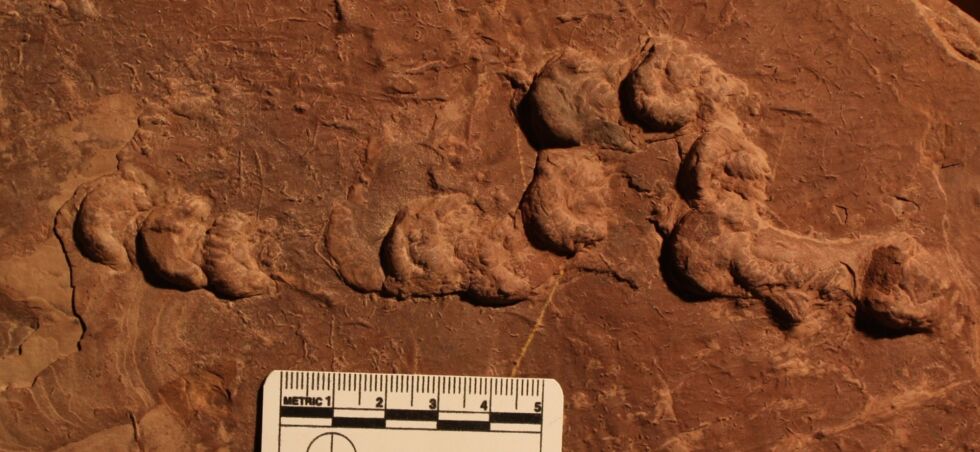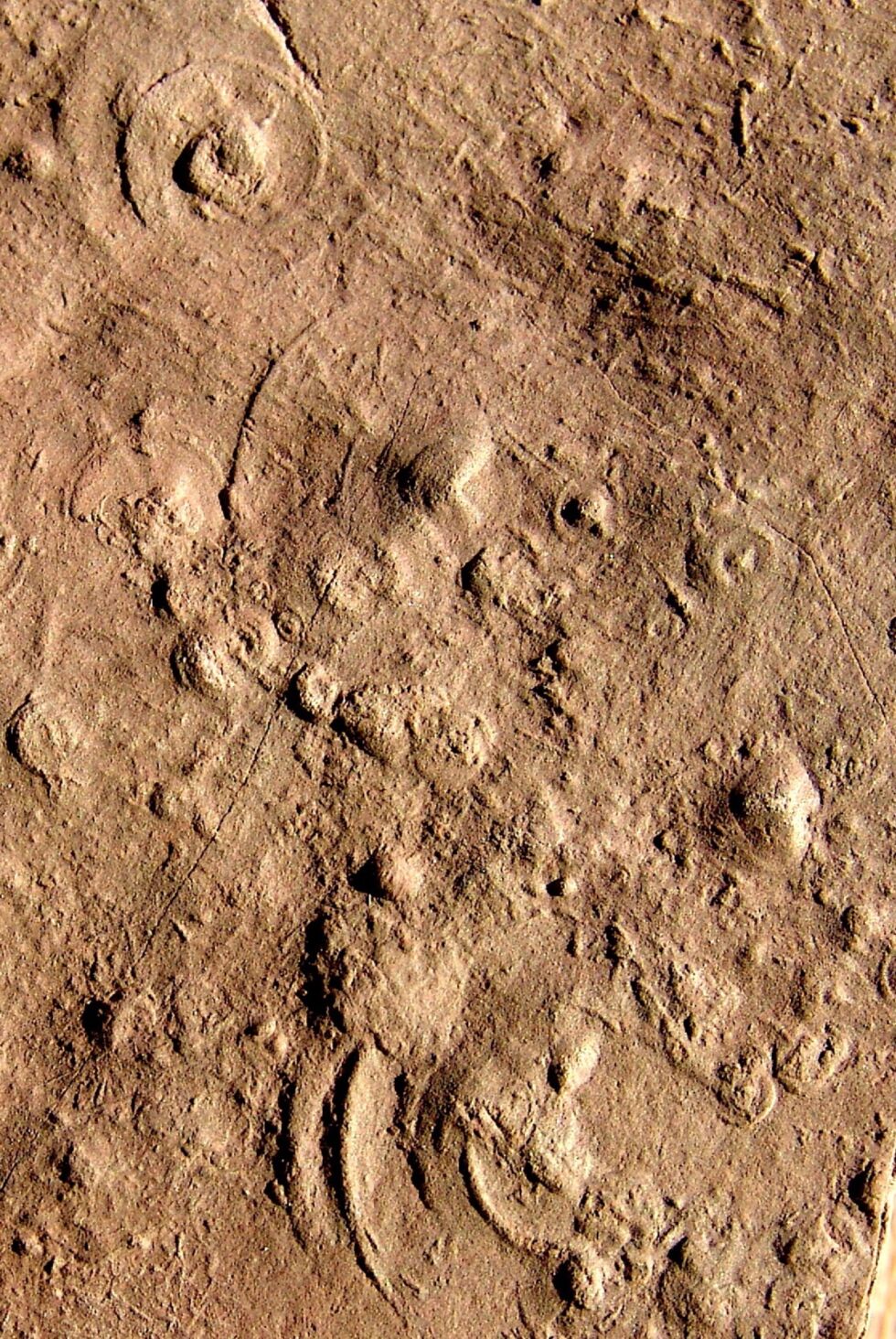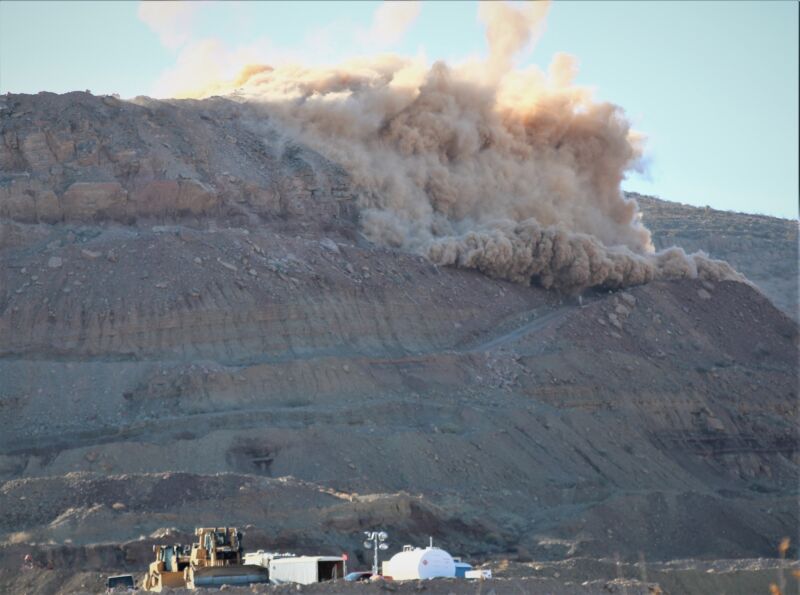Blasting has begun in an area known as “Community Pit #1” near Las Cruces, New Mexico, as part of a three-year effort by the Bureau of Land Management (BLM) to level dangerous high walls left in a once heavily mined pit (among other work). But the site is the only known location of certain fossils in the entire state, and some experts question whether the BLM is doing all that it can to balance maintaining public safety and preserving the fossils it is tasked with protecting.
In the Pit
The Community Pit is an area of approximately 85 acres near Prehistoric Trackways National Monument, which hosts a large range of vertebrate footprints. It became a source of building material in 1969, but this use ended in 2007. Scars from several decades of mining remain in the form of very high, very unstable rock walls. Current remediation efforts started because the “BLM observed an increase of visitors climbing upon and underneath undercuts and high walls,” explained William Wight, the BLM Las Cruces District spokesperson. “Due to increased reporting of this dangerous situation in late 2022, the BLM Las Cruces District Office made the Community Pit #1 public health and safety project a top district priority.”
The scope of that project involves “blasting, recontouring, seeding, and re-establishment of vegetation” in about 50 acres of the Community Pit. Blasting will largely impact the top layer of sediment making up the 150-foot walls. It is the rock layer lower in the pit—a geologic formation known as the Robledo Mountain Formation—that contains the fossils unique to the Community Pit: resting and burrowing traces made by jellyfish and horseshoe crabs from the Early Permian (approximately 290 million years or so ago). This is the only known location of jellyfish and horseshoe crab traces in New Mexico.

The BLM Environmental Assessment for this project acknowledges that the heavy equipment used to move the blasted material and reshape the area may damage these fossils and “reduce their scientific value.” It also notes that other layers at the site, which could also be impacted, have “very high potential for scientifically important vertebrate and invertebrate trace fossils…”
Balancing science and safety
Long before the current project, paleontologists advised the BLM Las Cruces District office on preserving the fossils within the Community Pit. One of those paleontologists is Spencer Lucas, curator of paleontology at the NM Museum of Natural History & Science, whose work at the site is cited extensively in the BLM’s Environmental Assessment. In an interview with Ars, Lucas said he and his scientific colleagues recommended—not once, but twice—that the BLM preserve fossils within the Community Pit and make an outdoor exhibit to showcase features exposed by the mining. They recommended doing so in conjunction with making the pit safer for the public.
The first set of recommendations, he said, were made in 1994 in an unpublished BLM report created by Lucas and his colleagues. Similar suggestions were made to the BLM in another report he co-authored in 2013. The BLM ignored them, he says.
When asked about this, Wight explained that these reports were considered, but in order to “facilitate and ensure public safety, the action BLM is taking is necessary.” Public exhibits, he said, would have to wait for a future planning process.
Ensuring public safety and protecting fossils are not necessarily mutually exclusive. And the BLM will have a paleontologist monitor the area prior to and after blasting. Beyond that, things are flexible. “The day-to-day tasks of paleontological monitoring,” Wight stated, “will adapt and adjust as material is exposed that could potentially contain trace fossils. Duration of monitoring is as needed.” Should a worker happen to notice the tiny trace fossils and halt construction, the initial person authorized to decide how best to proceed will be a BLM manager.
Workers and machine operators will be trained to know what to look for through a program known as ‘Worker’s Environmental Awareness Program (WEAP)’. Trace fossils, however, can be challenging to identify even for experienced ichnologists (those who study trace fossils). Perhaps more importantly, at this site, “most of these traces are the size of a half-dollar or smaller,” Lucas said. “So how are you going to see them, especially from a bulldozer or a truck?”
Leaving traces
Construction projects throughout the US often turn to resource-mitigation companies—businesses staffed by paleontologists and/or archaeologists who survey sites for fossils or artifacts before construction begins. Should either be found, these experts can then excavate them. Eric Scott is a vertebrate paleontologist and vice president of Cogstone Resource Management, one such company in California.
After discussing the current Community Pit project, Scott said, “ If it were up to me, I’d be very careful about this,” noting the proximity to Prehistoric Trackways.
BLM documents indicate that 60 percent of the known locations of jellyfish and horseshoe crab traces in the pit may be impacted or damaged by the work. While the BLM suggests that similar traces may be found elsewhere, so far, no one has looked. “If I were [the BLM], I would have preferred that they had said these identical things are present in abundance outside of this area so you lose nothing,” Scott offered. “And that’s not what they’re saying. They’re saying, ‘There’s a good chance we’ll find them if we’re proactive.’ There’s no guarantee that they’ll be proactive. So there’s no guarantee that those things will be found.”
The BLM did give interested parties an opportunity to suggest less damaging approaches. Before starting work at the site, the BLM posted information detailing possible impacts on the area and alternative options it had considered. Public comment was invited between June 28 and July 14, 2023.
A notification letter was also sent to those in the community. Additionally, Wight said it went to “13 federally recognized tribes” and “the chairperson for the Government Affairs Committees of the Society of Vertebrate Paleontology, the Paleontological Society, the Geological Society of America, the New Mexico Geological Society, and the New Mexico State University Geological sciences department.” While the BLM Las Cruces District “received responses from several tribes,” the BLM didn’t provide details regarding their responses. No one from any of the aforementioned geological or paleontological organizations responded, Wight added.
Ars reached out to all five organizations and heard back from three by the time of publication. Kevin Hobbs, president of the NM Geological Society, was “unaware of the BLM project.” Nancy McMillan, head of the NM State University Geological Sciences department, believes she may have seen the BLM letter but was unable to reply, given academic demands at the time.
The Society of Vertebrate Paleontology (SVP) opened the letter in early July but could not comment by the July 14 deadline. Kenshu Shimada, chair of SVP’s Government Affairs Committee, said its lack of response should not be interpreted as a disinterest in the project or its outcomes. Rather, “the timing of that particular Las Cruces BLM’s proposed plans for public comment (and an incredibly short public comment period) regrettably simply did not work out for us.” Everyone involved in SVP is a volunteer, and “for many paleontologists, summer is a primary fieldwork season,” Shimada noted.
And this, wrote Margaret Lewis, is significant.
Lewis is the SVP president. “It is really important to SVP to respond to matters impacting the science of paleontology,” she wrote to Ars, “but we must respond in a thoughtful manner where we have made sure that we have understood the issues and thought about the implications of whatever is being proposed… We view fossils and fossil localities on public land as a critical part of the public trust.”
What we could lose
The more we know about extinct species—their distribution, their evolution, the changes they made through time—all of this adds to our understanding of the world we live in. Trace fossils are important pieces of this puzzle, especially as they record the behaviors of the animals that made them.

Arturo Heredia is an assistant researcher at the Research Institute in Paleobiology and Geology (IIPG, National University of Río Negro-CONICET, Argentina) who studies trace fossils. In a video interview, Heredia noted that trace fossils are sometimes the only evidence we have that a species even existed—something that’s often true for soft-bodied animals like jellyfish, which have bodies that usually don’t survive fossilization. He pointed to the 2013 work from his colleague, Diana E. Fernández, in which she and Pablo Pazos used trace fossils in Argentina to provide the first evidence that ancient horseshoe crabs lived in South America.
Knowing that a species exists is one thing, but trace fossils also help us learn about the environment in which that species lived, he continued. “Understanding the environmental preferences and spatial distribution of horseshoe crabs in ancient times helps to understand the current distribution and ecology of these organisms, such as along the North America Atlantic coast,” he stated.
Because jellyfish and horseshoe crab traces are known from the same rock formation in the Community Pit, “you can infer that they lived together,” he said. He wonders if there are other as-yet unknown marine traces to be found.
While horseshoe crab traces may not have the same draw as the footprints of large Paleozoic protomammals known as synapsids found at nearby Prehistoric Trackways National Monument, that doesn’t mean they have less value.
Scott Foss is the BLM senior paleontologist. He was not involved in the Las Cruces District project, but he discussed the Paleontological Resources Preservation Act in a video interview. “The law doesn’t call out whether non-vertebrate and vertebrate fossils are more important or more valued,” he clarified. Non-vertebrate fossils such as those of invertebrates and plants, he said, “have the potential to elucidate more about the history of life on Earth than vertebrate fossils because of their relative abundance and because these organisms are/were more sensitive to climatic changes,” he said. “But as a land-managing organization, we are more concerned about preserving vertebrate fossils because they are rare and are more susceptible to damage from competing uses of the land.”
For Lucas, who has studied the area and knows the fossils involved, the way forward is clear. “I would say it’s a legitimate statement to say, ‘Yeah, these rock formations are elsewhere, so if we damage them or cover them over, we don’t lose all of it,” he said. “But we’re still losing important fossils.’ And [the BLM knows] that. They’ve been told that. It’s been documented.”
